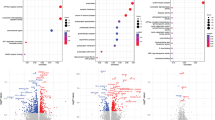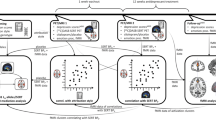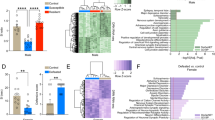Abstract
A variable number of tandem repeats (short (S) vs long (L)) in the promoter region of the serotonin transporter gene (5-HTTLPR) and a functional variant of a single-nucleotide polymorphism (rs25531) in 5-HTTLPR have been recently associated with increased risk for major depressive disorder (MDD). In particular, relative to L/L or LA homozygotes (hereafter referred to as L′ participants), S carriers or Lg-allele carriers (S′ participants) have been found to have a higher probability of developing depression after stressful life events, although inconsistencies abound. Previous research indicates that patients with MDD are characterized by executive dysfunction and abnormal activation within the anterior cingulate cortex (ACC), particularly in situations requiring adaptive behavioral adjustments following errors and response conflict (action monitoring). The goal of this study was to test whether psychiatrically healthy S′ participants would show abnormalities similar to those of MDD subjects. To this end, 19 S′ and 14 L′ participants performed a modified Flanker task known to induce errors, response conflict, and activations in various ACC subdivisions during functional magnetic resonance imaging. As hypothesized, relative to L′ participants, S′ participants showed (1) impaired post-error and post-conflict behavioral adjustments; (2) larger error-related rostral ACC activation; and (3) lower conflict-related dorsal ACC activation. As similar behavioral and neural dysfunctions have been recently described in MDD patient samples, the current results raise the possibility that impaired action monitoring and associated ACC dysregulation may represent risk factors increased vulnerability to depression.
Similar content being viewed by others
Log in or create a free account to read this content
Gain free access to this article, as well as selected content from this journal and more on nature.com
or
References
Althaus M, Groen Y, Wijers AA, Mulder LJ, Minderaa RB, Kema IP et al (2009). Differential effects of 5-HTTLPR and DRD2/ANKK1 polymorphisms on electrocortical measures of error and feedback processing in children. Clin Neurophysiol 120: 93–107.
Anand A, Li Y, Wang Y, Wu J, Gao S, Bukhari L et al (2005). Activity and connectivity of brain mood regulating circuit in depression: a functional magnetic resonance study. Biol Psychiatry 57: 1079–1088.
Austin MP, Mitchell P, Goodwin GM (2001). Cognitive deficits in depression: possible implications for functional neuropathology. Br J Psychiatry 178: 200–206.
Ball D, Hill L, Freeman B, Eley TC, Strelau J, Riemann R et al (1997). The serotonin transporter gene and peer-rated neuroticism. Neuroreport 8: 1301–1304.
Beats BC, Sahakian BJ, Levy R (1996). Cognitive performance in tests sensitive to frontal lobe dysfunction in the elderly depressed. Psychol Med 26: 591–603.
Beck AT, Steer RA, Brown GK (1996). Beck Depression Inventory Manual, 2nd ed. The Psychological Corportation, San Antonio, TX.
Beitchman JH, Davidge KM, Kennedy JL, Atkinson L, Lee V, Shapiro S et al (2003). The serotonin transporter gene in aggressive children with and without ADHD and nonaggressive matched controls. Ann N Y Acad Sci. 1008: 248–251.
Boksem MA, Tops M, Wester AE, Meijman TF, Lorist MM (2006). Error-related ERP components and individual differences in punishment and reward sensitivity. Brain Res 1101: 92–101.
Botvinick M, Nystrom LE, Fissell K, Carter CS, Cohen JD (1999). Conflict monitoring versus selection-for-action in anterior cingulate cortex. Nature 402: 179–181.
Broekman BFP, Olff M, Boer F (2007). The genetic background of PTSD. Neurosci Biobehav Rev 31: 348–362.
Brown GW, Harris TO (2008). Depression and the serotonin transporter 5-HTTLPR polymorphism: a review and a hypothesis concerning gene-environment interaction. J Affect Disord 111: 1–12.
Brown SM, Hariri AR (2006). Neuroimaging studies of serotonin gene polymorphisms: exploring the interplay of genes, brain, and behavior. Cogn Affect Behav Neurosci 6: 44–52.
Buckner RL, Andrews-Hanna JR, Schacter DL (2008). The brain's default network: anatomy, function, and relevance to disease. Ann NY Acad Sci 1124: 1–38.
Bugg JM (2008). Opposing influences on conflict-driven adaptation in the Eriksen flanker task. Mem Cogn 36: 1217–1227.
Caspi A, Sugden K, Moffitt TE, Taylor A, Craig IW, Harrington H et al (2003). Influence of life stress on depression: moderation by a polymorphism in the 5-HTT gene. Science 301: 386–389.
Chiu PH, Deldin PJ (2007). Neural evidence for enhanced error detection in major depressive disorder. Am J Psychiatry 164: 608–616.
Cohen S, Kamarck T, Mermelstein R (1983). A global measure of perceived stress. J Health Soc Behav 24: 385–396.
Compton RJ, Robinson MD, Ode S, Quandt LC, Fineman SL, Carp J (2008). Error monitoring ability predicts daily stress regulation. Psych Science 19: 702–708.
Conway M, Howell A, Giannopoulos C (1991). Dysphoria and thought suppression. Cogn Ther Res 15: 153–166.
Critchley HD, Daly E, Phillips M, Brammer M, Bullmore E, Williams S (2000a). Explicit and implicit neural mechanisms for processing of social information from facial expressions: a functional magnetic resonance imaging study. Hum Brain Mapp 9: 93–105.
Critchley HD, Elliott R, Mathias CJ, Dolan RJ (2000b). Neural activity relating to generation and representation of galvanic skin conductance responses: a functional magnetic resonance imaging study. J Neurosci 8: 3033–3040.
Dannlowski U, Ohrmann P, Bauer J, Deckert J, Hohoff C, Kugel H et al (2008). 5-HTTLPR biases amygdala activity in response to masked facial expressions in major depression. Neuropharmacol 33: 418–424.
Dannlowski U, Ohrmann P, Konrad C, Domschke K, Bauer J, Kugel H et al (2009). Reduced amygdala-prefrontal coupling in major depression: association with MAOA genotype and illness severity. Int J Neuropsychopharmacol 12: 11–22.
Deary IJ, Battersby S, Whiteman MC, Connor JM, Fowkes FG, Harmar A (1999). Neuroticism and polymorphisms in the serotonin transporter gene. Psychol Med 29: 735–739.
Deichmann R, Gottfried JA, Hutton C, Turner R (2003). Optimized EPI for fMRI studies of the orbitofrontal cortex. Neuroimage 19: 430–441.
Eichele T, Debener S, Calhoun V, Specht K, Hugdahl K, von Cramon DY et al (2008). Prediction of human errors by maladaptive changes in event-related brain networks. Proc Natl Acad Sci USA 105: 6173–6178.
Elliott R, Sahakian BJ, McKay AP, Herrod JJ, Robbins TW, Paykel ES (1996). Neuropsychological impairments in unipolar depression: the influence of perceived failure on subsequent performance. Psychol Med 26: 975–989.
Endrass T, Klawohn J, Schuster F, Kathmann N (2008). Overactive performance monitoring in obsessive-compulsive disorder: ERP evidence from correct and erroneous reactions. Neuropsychologia 46: 1877–1887.
Falconer E, Bryant R, Felmingham KL, Kemp AH, Gordon E, Peduto A et al (2008). The neural networks of inhibitory control in posttraumatic stress disorder. J Psychiatry Neurosci 33: 413–422.
Fallgatter AJ, Herrmann MJ, Roemmler J, Ehlis AC, Wagener A, Heidrich A et al (2004). Allelic variation of serotonin transporter function modulates the brain electrical response for error processing. Neuropsychopharmacology 29: 1506–1511.
First MB, Spitzer RL, Gibbon M, Williams J (2007). Structured Clinical Interview for DSM-IV-TR Axis I Disorders—Patient Edition (SCID-I/P, 1/2007 revision). Biometrics Research, New York State Psychiatric Institute: New York.
Fischl B, van der KA, Destrieux C, Halgren E, Segonne F, Salat DH et al (2004). Automatically parcellating the human cerebral cortex. Cereb Cortex 14: 11–22.
Flory JD, Manuck SB, Ferrell RE, Dent KM, Peters DG, Muldoon MF (1999). Neuroticism is not associated with the serotonin transporter (5-HTTLPR) polymorphism. Mol Psychiatry 4: 93–96.
George MS, Ketter TA, Parekh PI, Rosinsky N, Ring HA, Pazzaglia PJ et al (1997). Blunted left cingulate activation in mood disorder subjects during a response interference task (the Stroop). J Neuropsychiatry Clin Neurosci 9: 55–63.
Gratton G, Coles MG, Donchin E (1992). Optimizing the use of information: strategic control of activation of responses. J Exp Psychol Gen 121: 480–506.
Hajcak G, McDonald N, Simons RF (2004). Error-related psychophysiology and negative affect. Brain Cogn 56: 189–197.
Hariri AR, Drabant EM, Munoz KE, Kolachana BS, Mattay VS, Egan MF et al (2005). A susceptibility gene for affective disorders and the response of the human amygdala. Arch Gen Psych 62: 146–152.
Hariri AR, Drabant EM, Weinberger DR (2006). Imaging genetics: perspectives from studies of genetically driven variation in serotonin function and corticolimbic affective processing. Biol Psychiatry 59: 888–897.
Hariri AR, Mattay VS, Tessitore A, Kolachana B, Fera F, Goldman D et al (2002). Serotonin transporter genetic variation and the response of the human amygdala. Science 297: 400–403.
Hasler G, Drevets WC, Manji HK, Charney DS (2004). Discovering endophenotypes for major depression. Neuropsychopharmacology 29: 1765–1781.
Holmes AJ, Pizzagalli DA (2008a). Response conflict and frontocingulate dysfunction in unmedicated participants with major depression. Neuropsychologia 46: 2904–2913.
Holmes AJ, Pizzagalli DA (2008b). Spatiotemporal dynamics of error processing dysfunctions in major depressive disorder. Arch Gen Psychiatry 65: 179–188.
Holroyd CB, Coles MG (2002). The neural basis of human error processing: reinforcement learning, dopamine, and the error-related negativity. Psychol Rev 109: 679–709.
Hu X, Oroszi G, Chun J, Smith TL, Goldman D, Schuckit MA (2005). An expanded evaluation of the relationship of four alleles to the level of response to alcohol and the alcoholism risk. Alcohol Clin Exp Res 29: 8–16.
Katsuragi S, Kunugi H, Sano A, Tsutsumi T, Isogawa K, Nanko S et al (1999). Association between serotonin transporter gene polymorphism and anxiety-related traits. Biol Psychiatry 45: 368–370.
Kendler KS, Thornton LM, Gardner CO (2001). Genetic risk, number of previous depressive episodes, and stressful life events in predicting onset of major depression. Am J Psychiatry 158: 582–586.
Kerns JG, Cohen JD, MacDonald III AW, Cho RY, Stenger VA, Carter CS (2004). Anterior cingulate conflict monitoring and adjustments in control. Science 303: 1023–1026.
Laming D (1979). Autocorrelation of choice-reaction times. Acta Psychol (Amst) 43: 381–412.
Lemogne C, Bastard G, Mayberg H, Volle E, Bergouignan L, Lehericy S (2009). In search of the depressive self: extended medial prefrontal network during self-referential processing in major depression. Soc Cogn Affect Neur 4: 305–312.
Maddock RJ, Buonocore MH (1997). Activation of left posterior cingulate gyrus by the auditory presentation of threat-related words: an fMRI study. Psychiatry Res 75: 1–14.
Mayr U, Awh L, Laurey P (2003). Conflict adaptation effects in the absence of executive control. Nat Neurosci 6: 450–452.
Munafo M, Brown S, Hariri AR (2008). Serotonin transporter (5-HTTLPR) genotype and amygdala activation: a meta-analysis. Biol Psychiatry 63: 852–857.
Murphy DL, Fox MA, Timpano KR, Moya PR, Ren-Patterson R, Andrews AA et al (2008). How the serotonin story is being rewritten by new gene-based discoveries principally related to SLC6A4, the serotonin transporter gene, which functions to influence all cellular serotonin systems. Neuropharmacol 55: 932–960.
Ochsner KN, Gross JJ (2005). The cognitive control of emotion. Trends Cogn Sci 9: 242–249.
Ochsner KN, Gross JJ (2008). Cognitive emotion regulation: insights from social cognitive and affective neuroscience. Curr Dir Psychol Sci 17: 153–158.
Ochsner KN, Hughes B, Robertson ER, Cooper JC, Gabrieli JDE (2009). Neural systems supporting the control of affective and cognitive conflicts. J Cogn Neurosci 21: 1841–1854.
Olvet DM, Hajcak G (2008). The error-related negativity (ERN) and psychopathology: toward an endophenotype. Clin Psychol Rev 28: 1343–1354.
Paradiso S, Lamberty GJ, Garvey MJ, Robinson RG (1997). Cognitive impairment in the euthymic phase of chronic unipolar depression. J Nerv Ment Dis 185: 748–754.
Pezawas L, Meyer-Lindenberg A, Drabant EM, Verchinski BA, Munoz KE, Kolachana BS et al (2005). 5-HTTLPR polymorphism impacts human cingulate-amygdala interactions: a genetic susceptibility mechanism for depression. Nat Neurosci 8: 828–834.
Phillips ML, Ladouceur CD, Drevets WC (2008). A neural model of voluntary and automatic emotion regulation: implications for understanding the pathophysiology and neurodevelopment of bipolar disorder. Mol Psychiatry 13: 833–857.
Prathikanti S, Weinberger DR (2005). Psychiatric genetics—the new era: genetic research and some clinical implications. Br Med Bull 73–74: 107–122.
Rabbitt PM (1966). Errors and error correction in choice-response tasks. J Exp Psychol 71: 264–272.
Ridderinkhof KR, Ullsperger M, Crone EA, Nieuwenhuis S (2004). The role of the medial frontal cortex in cognitive control. Science 306: 443–447.
Risch N, Herrell R, Lehner T, Liang KY, Eaves L, Hoh J et al (2009). Interaction between the serotonin transporter gene (5-HTTLPR), stressful life events, and risk of depression: a meta-analysis. JAMA 301: 2462–2471.
Sanders AR, Duan J, Gejman PV (2004). Complexities in psychiatric genetics. Int Rev Psychiatry 16: 284–293.
Savitz JB, Drevets WC (2009). Imaging phenotypes of major depressive disorder: genetic correlates. Neuroscience 164: 300–330.
Schrijvers D, de Bruijn ER, Maas Y, De Grave C, Sabbe BG, Hulstijn W (2008). Action monitoring in major depressive disorder with psychomotor retardation. Cortex 44: 569–579.
Schrijvers D, de Bruijn ER, Maas YJ, Vancoillie P, Hulstijn W, Sabbe BG (2009). Action monitoring and depressive symptom reduction in major depressive disorder. Int J Psychophysiol 71: 218–224.
Shah MP, Wang F, Kalmar JH, Chepenik LG, Tie K, Pittman B et al (2009). Role of variation in the serotonin transporter protein gene (SLC6A4) in trait disturbances in the ventral anterior cingulate in bipolar disorder. Neuropharmacol 34: 1301–1310.
Siegle GJ, Steinhauer SR, Thase ME (2004). Pupillary assessment and computational modeling of the Stroop task in depression. Int J Psychophysiol 52: 63–76.
Siegle GJ, Thompson W, Carter CS, Steinhauer SR, Thase ME (2007). Increased amygdala and decreased dorsolateral prefrontal BOLD responses in unipolar depression: related and independent features. Biol Psychiatry 61: 198–209.
Sullivan PF, Neale MC, Kendler KS (2000). Genetic epidemiology of major depression: review and meta-analysis. Am J Psychiatry 157: 1552–1562.
Ullsperger M, Bylsma LM, Botvinick MM (2005). The conflict adaptation effect: it's not just priming. Cogn Affect Behav Neurosci 5: 467–472.
van Veen V, Carter CS (2002). The anterior cingulate as a conflict monitor: fMRI and ERP studies. Physiol Behav 77: 477–482.
Vanderhasselt MA, De Raedt R (2009). Impairments in cognitive control persist during remission from depression and are related to the number of past episodes: an event related potential study. Biol Psychol 81: 169–176.
Vogt BA, Nimchinsky EA, Vogt LJ, Hof PR (1995). Human cingulate cortex: surface features, flat maps, and cytoarchitecture. J Comp Neurol 359: 490–506.
Wager TD, Nichols TE (2003). Optimization of experimental design in fMRI: a general framework using a genetic algorithm. Neuroimage 18: 293–309.
Wager TD, Sylvester CY, Lacey SC, Nee DE, Franklin M, Jonides J (2005). Common and unique components of response inhibition revealed by fMRI. Neuroimage 27: 323–340.
Watson D, Weber K, Assenheimer JS, Clark LA, Strauss ME, McCormick RA (1995). Testing a tripartite model: I. Evaluating the convergent and discriminant validity of anxiety and depression symptom scales. J Abnorm Psychol 104: 3–14.
Wendland JR, Martin BJ, Kruse MR, Lesch KP, Murphy DL (2006). Simultaneous genotyping of four functional loci of human SLC6A4, with a reappraisal of 5-HTTLPR and rs25531. Mol Psychiatry 11: 224–226.
Wenzlaff RM, Grozier SA (1988). Depression and the magnification of failure. J Abnorm Psychol 97: 90–93.
Wiersema JR, van der Meere JJ, Roeyers H (2009). ERP correlates of error monitoring in adult ADHD. J Neural Transm 116: 371–379.
Wong ML, Licinio J (2001). Research and treatment approaches to depression. Nat Rev Neurosci 2: 343–351.
Zalsman G, Huang YY, Oquendo MA, Burke AK, Hu XZ, Brent DA et al (2006). Association of a triallelic serotonin transporter gene promoter region (5-HTTLPR) polymorphism with stressful life events and severity of depression. Am J Psychiatry 163: 1588–1593.
Acknowledgements
This study was funded by a Sackler Scholar in Psychobiology Research Grant (RB), a National Institute of Health Training Grant 1 F31MH078346 (AJH), and NIMH Research Grants R01MH68376 and R21MH078979 (DAP). We thank Nancy Brooks, Alison Brown, Daniel G Dillon, Jesen Fagerness, Miles Nugent, Roy H Perlis, Sara Rubenstein, and Patrice Vamivakas for their contributions and assistance with various aspects of this research.
Author information
Authors and Affiliations
Corresponding author
Ethics declarations
Competing interests
The authors declare that over the past 3 years, Dr Pizzagalli has received research support from GlaxoSmithKline, Merck and ANT North America (Advanced Neurotechnology) for projects unrelated to the current study; consulting fees from ANT and AstraZeneca, and honoraria from AstraZeneca. Dr Holmes and Mr Bogdan declare no competing interests.
Rights and permissions
About this article
Cite this article
Holmes, A., Bogdan, R. & Pizzagalli, D. Serotonin Transporter Genotype and Action Monitoring Dysfunction: A Possible Substrate Underlying Increased Vulnerability to Depression. Neuropsychopharmacol 35, 1186–1197 (2010). https://doi.org/10.1038/npp.2009.223
Received:
Revised:
Accepted:
Published:
Issue date:
DOI: https://doi.org/10.1038/npp.2009.223
Keywords
This article is cited by
-
Neural Correlates of Three Promising Endophenotypes of Depression: Evidence from the EMBARC Study
Neuropsychopharmacology (2016)
-
Abnormal error processing in depressive states: a translational examination in humans and rats
Translational Psychiatry (2015)
-
Association of serotonin transporter gene (5HTT) polymorphism and juvenile myoclonic epilepsy: a case–control study
Acta Neurologica Belgica (2015)
-
Monoaminergic modulation of behavioural and electrophysiological indices of error processing
Psychopharmacology (2014)
-
Frontocingulate Dysfunction in Depression: Toward Biomarkers of Treatment Response
Neuropsychopharmacology (2011)



